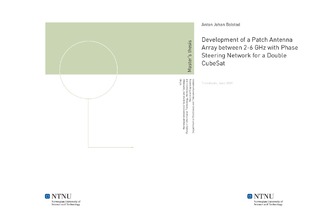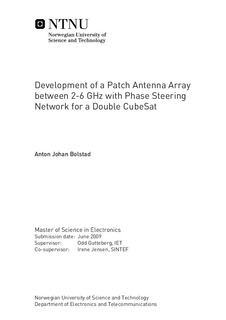| dc.contributor.advisor | Gutteberg, Odd | nb_NO |
| dc.contributor.author | Bolstad, Anton Johan | nb_NO |
| dc.date.accessioned | 2014-12-19T13:44:18Z | |
| dc.date.accessioned | 2015-12-22T11:42:12Z | |
| dc.date.available | 2014-12-19T13:44:18Z | |
| dc.date.available | 2015-12-22T11:42:12Z | |
| dc.date.created | 2010-09-04 | nb_NO |
| dc.date.issued | 2009 | nb_NO |
| dc.identifier | 348844 | nb_NO |
| dc.identifier.uri | http://hdl.handle.net/11250/2369433 | |
| dc.description.abstract | To make a double CubeSat with limited power resources capable of transmitting large amounts of data to Earth a high gain antenna is needed. In this thesis a switched beam MSA array operating at 5.84 GHz has been designed to operate on a double CubeSat. The array has 5 beams and uses a switched-line phase shifter to switch between beams. Three different array geometries has been proposed. Computer simulations suggest that the array should be capable of an effective beamwidth of over 60 degrees with a directivity of over 11 dBi. A feed network has been designed to fit the best suited geometry. A ground plane will separate the feed network from the antenna elements. Along with the full array solution all the sub parts has been realized as test circuits. This allows for an evaluation of their characteristics. A TRL calibration kit has also been designed so that the sub parts could be more accurately evaluated. When sending the circuits to fabrication it appeared to be a problem with the selected substrate used for the antenna elements. A redesign using the same substrate for the feed network and antennas was done and production commenced. As it turns out, the TRL calibration kit was not good enough so the S-parameters had to be measured with regular SOLT calibration. Significant problems with connection to ground and mismatches due to a poor SMA-to-microstrip transition was encountered. This caused large deviations between measured and simulated results. It was also discovered that the wrong dielectric constant had been used. This error caused the antenna elements to be dimensioned for operation at 5.70 GHz instead of 5.84 GHz. Problems was also encountered in the switched line phase shifter design. Beam-lead PIN-diodes has been used and due to their small size, a sufficient quality of the soldering was not achieved. This lead to different losses through the phase shifter which again caused the different beam directions to vary from simulations. Only one beam had characteristics similar to simulations. Measurements on the array without phase shifters showed good correspondence with simulation results (adjusted for the correct dielectric constant). It is concluded that by making a better SMA-to-microstrip transition, improve the soldering work and do a redesign with the correct dielectric constant, the array configuration should work as outlined in the design process. | nb_NO |
| dc.language | eng | nb_NO |
| dc.publisher | Institutt for elektronikk og telekommunikasjon | nb_NO |
| dc.subject | ntnudaim | no_NO |
| dc.title | Development of a Patch Antenna Array between 2-6 GHz with Phase Steering Network for a Double CubeSat | nb_NO |
| dc.type | Master thesis | nb_NO |
| dc.source.pagenumber | 193 | nb_NO |
| dc.contributor.department | Norges teknisk-naturvitenskapelige universitet, Fakultet for informasjonsteknologi, matematikk og elektroteknikk, Institutt for elektronikk og telekommunikasjon | nb_NO |

